Gibson, Stanwill John
Killed in Action 1944-01-29


Birth Date: 1919-February-26
Born: Woodstock, Oxford County Municipality, Ontario, Canada
Son of Charles Russell Gibson and Annie (nee Hodgson) Gibson of Caron, Saskatchewan
Home: Toronto, Ontario
Enlistment: Hamilton, Ontario
Enlistment Date: 1942-02-24
Service
RCAF
Unit
419 (B) Sqn- Squadron
Moosa Aswayita Beware of Moose
Base
RAF Middleton St George
Rank
Flying Officer
Position
Flying Officer
Service Numbers
J/25385
Halifax B/GR.Mk.II JP119
Bombing Berlin Germany 1944-January-28 to 1944-January-29
419 (B) Sqn (RCAF) RAF Middleton St. George
Battle of Berlin
677 aircraft - 432 Lancasters, 241 Halifaxes, 4 Mosquitoes. Part of the German fighter force was drawn up by the early diversions and the bomber approach route over Northern Denmark proved too distant for some of the other German fighters. The German controller was, however, able to concentrate his fighters over the target and many aircraft were shot down there. 46 aircraft - 26 Halifaxes, 20 Lancasters - lost, 6·8 per cent of the force.
.The cloud over Berlin was broken and some ground-marking was possible but the Bomber Command claim that this was the most concentrated attack of this period is not quite fully confirmed by German records. The western and southern districts were hit but so too were 77 places outside the. city. The Berlin recording system was now showing an increasing deterioration. No overall figure for property damage was recorded; approximately 180,000 people were bombed out on this night. Although many industrial firms were again hit, the feature of this night is the unusually high proportion of administrative and public buildings appearing in the lists of buildings hit: the new Chancellery, 4 theatres, the 'French' cathedral, 6 hospitals, 5 embassies, the State Patent Office, etc. The report concludes with this entry: 'The casualties are still not known but they are bound to be considerable. It is reported that a vast amount of wreckage must still be cleared; rescue workers are among the mountains of it..
source: The Bomber Command War Diaries, Martin Middlebrook and Chris Everitt
419 Moose Squadron (Moosa aswayita) RAF Middleton St George. Halifax BII aircraft JP 119 VR-O was a attacked by a night fighter, possibly Oberfeldwebel Hans Berschwinger of the 4/NJG 2 before suffering a mid-air collision with 7 Squadron RAF Lancaster aircraft JA 718 during a raid on industrial targets in western and southern Berlin, Germany. Both aircraft crashed in the same area near Zuhlen, Rheinsberg, Brandenburg, Germany
The entire crew of Halifax JP 119 VR-O were lost. Two of seven crew on Lancaster III aircraft JA 718 MG-T were missing, presumed killed in action and three others killed in action. Two crew member from Lancaster JA 718 survived to become Prisoners of War
Pilot Officer F H Palmer (RCAF) and Pilot Officer E Milner (RCAF) on Halifax JP 119 were missing, presumed killed in action. The missing have no known grave and are commemorated on the Runnymede Memorial
The other crew members of Halifax JP 119: Flying Officer S J Gibson (RCAF), Flying Officer F Forrest (RCAF), Flying Officer G E Lemmerick (RCAF), Pilot Officer R Tarbet (RCAF), Sergeant J H Parrott (RAFVR) and Flight Sergeant F P Reilly (RAFVR) were all killed in action
 Royal Air Force Serial and Image Database
Royal Air Force Serial and Image Database
Halifax JP119
Handley Page Halifax

The Handley Page Halifax is a British Royal Air Force (RAF) four-engined heavy bomber of the Second World War. It was developed by Handley Page to the same specification as the contemporary twin-engine Avro Manchester.
The Halifax has its origins in the twin-engine HP56 proposal of the late 1930s, produced in response to the British Air Ministry's Specification P.13/36 for a capable medium bomber for "world-wide use." The HP56 was ordered as a backup to the Avro 679, both aircraft being designed to use the underperforming Rolls-Royce Vulture engine. The Handley Page design was altered at the Ministry to a four-engine arrangement powered by the Rolls-Royce Merlin engine; the rival Avro 679 was produced as the twin-engine Avro Manchester which, while regarded as unsuccessful mainly due to the Vulture engine, was a direct predecessor of the famed Avro Lancaster. Both the Lancaster and the Halifax would emerge as capable four-engined strategic bombers, thousands of which would be built and operated by the RAF and several other services during the War.
On 25 October 1939, the Halifax performed its maiden flight, and it entered service with the RAF on 13 November 1940. It quickly became a major component of Bomber Command, performing routine strategic bombing missions against the Axis Powers, many of them at night. Arthur Harris, the Air Officer Commanding-in-Chief of Bomber Command, described the Halifax as inferior to the rival Lancaster (in part due to its smaller payload) though this opinion was not shared by many of the crews that flew it, particularly for the MkIII variant. Nevertheless, production of the Halifax continued until April 1945. During their service with Bomber Command, Halifaxes flew a total of 82,773 operations and dropped 224,207 tons of bombs, while 1,833 aircraft were lost. The Halifax was also flown in large numbers by other Allied and Commonwealth nations, such as the Royal Canadian Air Force (RCAF), Royal Australian Air Force (RAAF), Free French Air Force and Polish forces.Wikipedia
 National Air Force Museum of Canada
National Air Force Museum of Canada
419 (B) Sqn Moosa Aswayita ("Moose")
History of the Squadron during World War II (Aircraft: Wellington IC, III, Halifax II, Lancaster X)
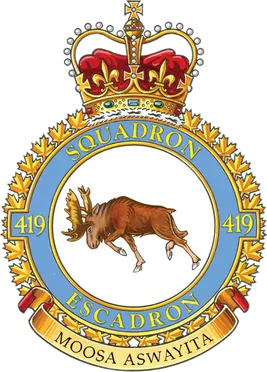
419 (Bomber) Squadron formed at RAF Mildenhall, Suffolk, UK in 1941 as part of No 3 Group of Bomber Command. It got its name from its first commanding officer, Wing Commander John "Moose" Fulton, DSO, DFC, AFC. The squadron operated Vickers Wellington, then Handley Page Halifax and finally Avro Lancaster bombers through the course of WWII, with the squadron code letters VR. It was the third RCAF bomber unit to be formed in England. It started operations in January 1942, converting almost immediately from Wellington Mk ICs to Wellington Mk IIIs and then moving north to Leeming, Yorkshire, as part of 4 Group Bomber Command in August 1942. After short stays at Topcliffe and Croft , it moved to Middleton St. George, County Durham in November 1942, from which it flew until the end of hostilities. Here in November 1942 it was re-equipped with Halifax Mk IIs, which it flew for the next 18 months on the night offensive against Germany. In January 1943 it joined the newly formed 6 (RCAF) Group of Bomber Command.
In April 1944 the squadron began to convert to the Avro Lancaster Mk X, which was produced in Canada and flown across the Atlantic. The squadron remained continuously on the offensive until 25 April 1945, when it flew its last sortie. Squadron personnel flew a total of 4,325 operational sorties during the war from Mannheim to Nuremberg, Milan to Berlin and Munich to Hanover, inflicting heavy damage on the enemy. On completion of the war in Germany, the squadron was earmarked to become part of the proposed "Tiger Force" to continue the war against Japan. However, the Japanese surrender in August 1945 led to the disbandment of the squadron in at Yarmouth, Nova Scotia September 1945.
As a result of its wartime record, 419 Squadron became one of the most decorated units under the RCAF during the war. Over a span of roughly three-and-a-quarter years it logged 400 operational missions (342 bombing missions, 53 mining excursions, 3 leaflet raids and 1 "spoof") involving 4,325 sorties. A total of one hundred and twenty nine aircraft were lost on these operations. Members of the squadron accumulated 1 VC, 4 DSO's, 1 MC, 150 DFC's, 3 bars to DFC, 1 CGM, 35 DFM's: the VC was awarded posthumously to Flight Sergeant Andrew Mynarski for his attempts to help a fellow crew member escape from their burning aircraft. Battle Honours were: English Channel and North Sea 1942-44, Baltic 1942-44, Fortress Europe 1942-44, France and Germany 1944-45, Biscay Ports 1942-44, Ruhr 1942-45, Berlin 1943-44, German Ports 1942-45, Normandy 1944, Rhine, Biscay 1942; 1944. Wikipedia, Kostenuk and Griffin
 Squadron History (Bomber Command Museum)
Squadron History (Bomber Command Museum)
Maps for Movements of 419 Squadron 1941-45
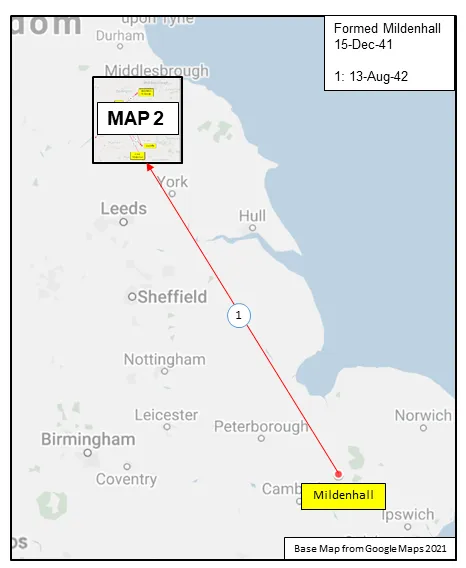 MAP 1: 419 Squadron Movements Dec 1941-Aug-42 (right-click on image to display enlarged new tab) | 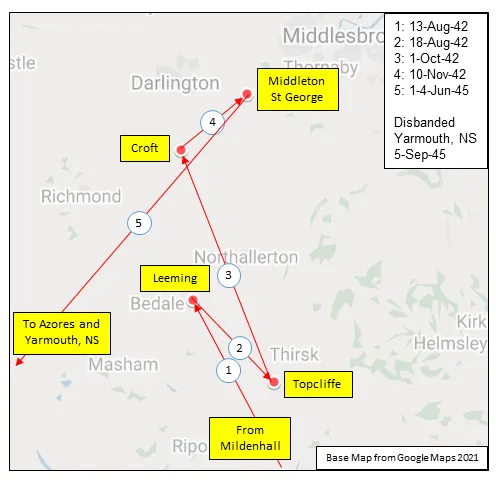 MAP 2: 419 Squadron Movements Aug 1942-Jun 1945 | 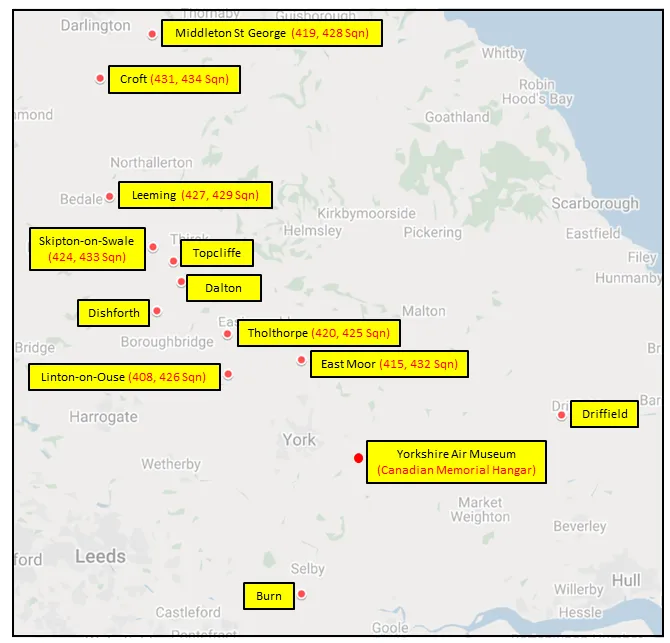 MAP 3: 6 Group Bomber Bases 1943-1945 |
419 Squadron History Summary 1941-45
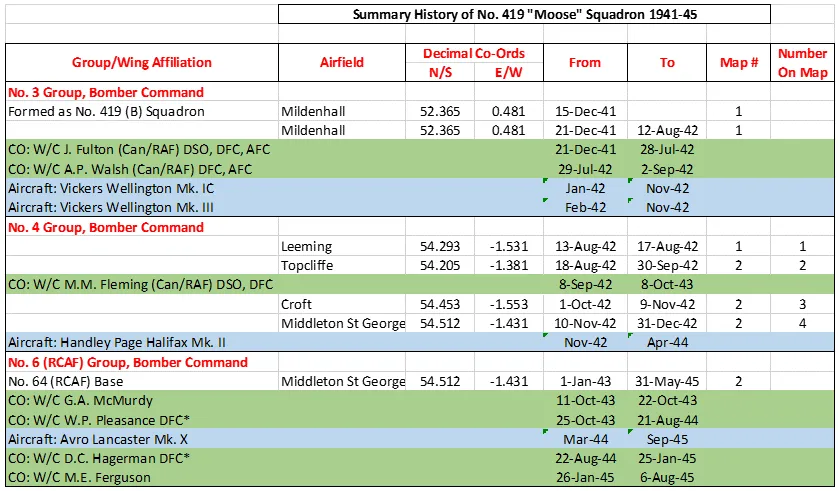
419 Squadron History Summary 1941-45 Page 2

History of the Squadron Post-WWII (Aircraft: Canuck, Silver Star, Freedom Fighter, Hornet)
The squadron was reactivated on 15 March 1954 at North Bay, Ontario , as an all-weather fighter squadron flying the CF-100 Canuck. It moved to the NATO Air Division base at Baden-Soellingen, Germany shortly after being formed. The squadron remained there until its disbandment in December 1962.
The squadron was again re-formed in December 1970, when it relocated to Cold Lake, Alberta as No. 1 Canadian Forces Flight Training School. It initially flew the T-33 Silver Star but then transitioned to the Canadair CF-5 Freedom Fighter. The squadron was on full active duty in November 1975 but disbanded again 20 years later when the CF-5’s were retired in June 1995.
The squadron was again reactivated as 419 Tactical Fighter (Training) Squadron on 23 July 2000. The squadron has since conducted Phase IV of the NATO Flying Training Canada (NFTC) program for the air forces of Canada, Austria, Denmark, Italy, Hungary, Saudi Arabia, Singapore, the United Arab Emirates and the United Kingdom. This program trains basic jet pilots to become fighter pilots and prepares them for training on CF-188 class aircraft through instruction in Air-to-Air and Air-to-Ground combat tactics over a six month period.
 Toronto, Ontario
Toronto, Ontario Canadian Virtual War Memorial
Canadian Virtual War Memorial Commonwealth War Graves Commission
Commonwealth War Graves Commission Findagrave.com
Findagrave.com Saskatchewan Virtual War Memorial
Saskatchewan Virtual War Memorial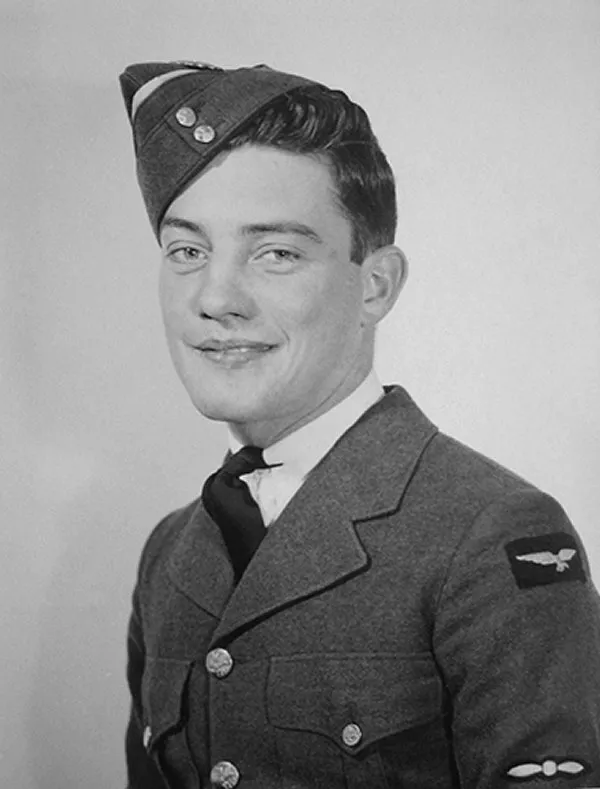
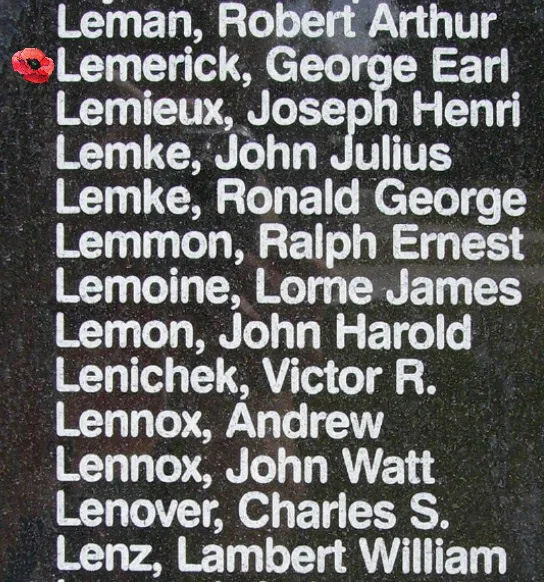
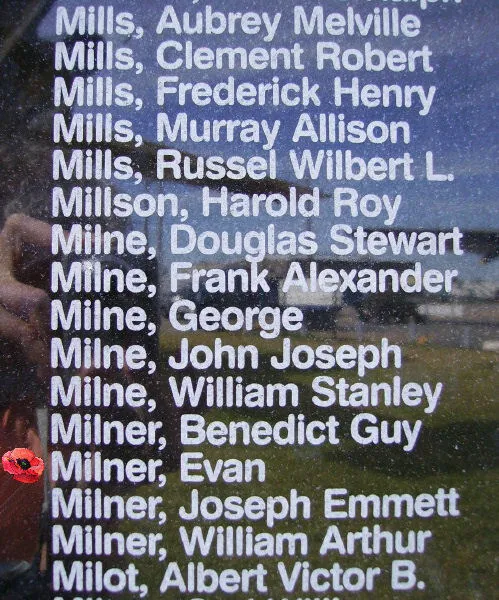




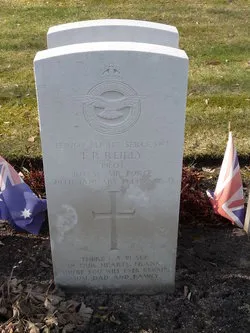
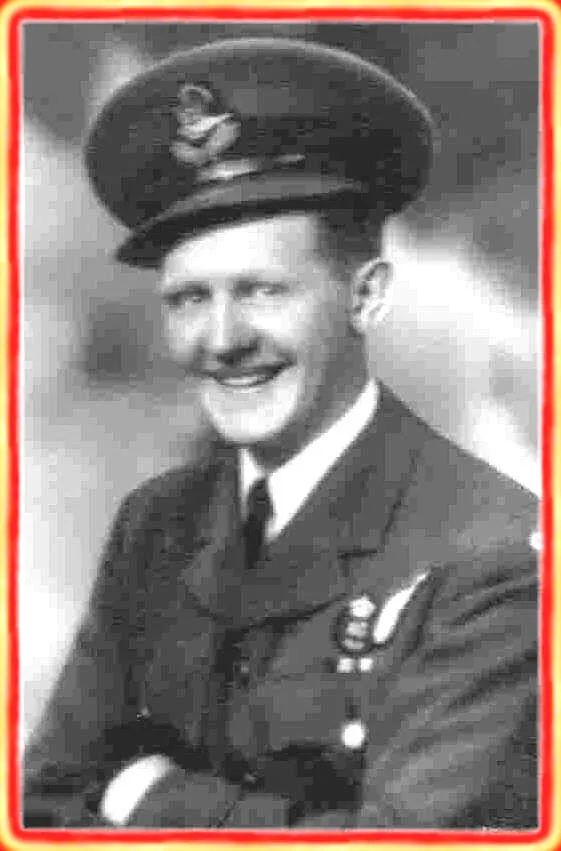
 Halifax Heavy Bomber WWII
Halifax Heavy Bomber WWII Wikipedia Halifax Bomber
Wikipedia Halifax Bomber